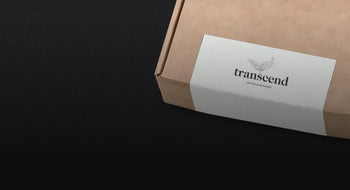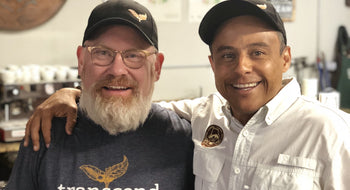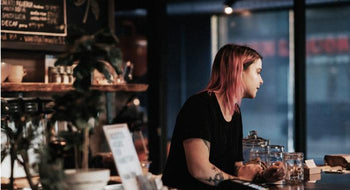Our Approach to Roasting Coffee

“Which coffee is your dark roast?” This is probably one of the most heard questions asked by newcomers in our cafes. And frankly, we understand why. Dark roasted coffee is ubiquitous within the marketplace thanks to the influence of the green mermaid. And while there is much to be thankful for in terms of the coffee revolution in North America due to the work of Starbucks, a dark roast isn’t one of them. Obviously the dark roasted “bold” charcoal flavours found in the Starbucks cup in the early days were a welcome departure from the under extracted and stale coffee from the myriad of tin cans found on grocery store shelves. Who wasn’t tired of drinking flavourless brown water?
From the very origin of Transcend Coffee, our response to the roasting level question was to celebrate the quality of coffee, and try our best not to obscure that quality by going dark. Obviously this is a preference of ours, and is one that our customers have had to adopt as their own. If you drink dark roasted coffee and enjoy it, who are we to tell you otherwise. But our preference is to roast coffee to a medium light level, wherein we hope that the unique characteristics of each coffee that survive the roasting process will shine through and be enjoyed in a well brewed cup.
Roasting coffee isn’t all that complicated. It has been done now for probably over one thousand years. In early days, and still practiced in Ethiopia, coffee was roasted over an open fire. This is obviously a rustic method, and offers very little in terms of finesse. But, it is essentially what every coffee roaster does in one way or another. We at Transcend roast coffee is a vintage gas fired drum roaster (circa 1950s 22kg Probat). This machine isn’t adorned with bells and whistles either. It has a bank of gas burners located under a cast iron drum which rotates. There is a fan which moves air around in the drum, and the coffee is heated both via contact with the hot iron and via the hot air.
The challenge in roasting coffee is in the process of transforming a green coffee seed that is almost dry (12% moisture content) into a dried out, Maillard effected something else. The challenge with roasting coffee is having a product at the end of the process that when ground and brewed tastes amazing. While roasting coffee isn’t hard, not screwing up the roasting process is very difficult. There are so many things that can go wrong in the roasting process, resulting in off-putting flavours that are herbaceous or vegetal, or simply burnt. The challenge of having an end product which is sweet, vibrant, dynamic, and flavourful is where the art comes into roasting coffee.
The science involved in the roasting process is massively complicated and frankly, no one really knows with certainty what is transpiring within the seed during the roasting process. Simply stated, the chemistry is sophisticated as you apply heat to sugar, amino acids, proteins, oils, H20 all trapped within a cellular structure. One of the major chemical reactions that occurs during roasting is the Maillard reaction (a browning reaction due to the application of heat similar to that which happens when you sear a steak or bake bread). In this chemical reaction amino acids and reducing sugars interact to create flavour compounds. The obvious challenge is trying to control and replicate the process so that you can achieve a consistent and tasty bi-product with which to brew a great cup.
Transcend has always espoused the notion that we as a roaster simply highlight and celebrate the unique characteristics of what is inherent within the seed. We have always championed the notion of terroir and the influence of the people who grow the coffee we buy. And while this is all true, we must also acknowledge that roasting coffee is a massively destructive process, wherein the coffee seed is hugely influenced by the roasting process. So while we know that the coffee which comes from Ricardo Perez’s biodynamic plot named for his oldest daughter tastes different than that grown by his neighbour’s coffee, we also know that we have a lot to do with the final flavour profile. We know this because the same green coffee put into the hands of ten roasters will result in ten different flavour profiles.
Despite all of the challenges that roasting coffee presents, we know that our roasting team is one of the best in the country. From sourcing to roasting and packaging, our dedicated team takes their jobs very seriously. Their attention to detail speaks for itself. Our coffee is roasted to a medium light roast level, which rarely results in anything but fully developed and flavourful coffee. We know that origin is evident in the final flavour profiles of our roasted coffee, and we are very proud of the work that we do to celebrate the hard work of our partner producers.
Roasting coffee is both simple and complex, both science and art. It is that beautiful process which starts with a nearly tasteless seed of potential and transforms it into a package of flavour and pleasure. Roasting coffee is what drives us forward each day to do what we do with more care and skill and passion. We taste the fruits of our labour with joy each day, and hope you do too.



Leave a comment